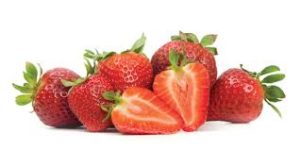Office to Home; Inside to Out
- By Chris Mittelstaedt
- Last Updated On
- Reading Time: 2 mins.
In my daydreaming mind, skyscrapers in cities all across America turn Chia Pet and sprout Alfalfa as a cover crop on their roofs; highway medians spontaneously erupt with tomato vines causing traffic jams as commuters stop to pick fresh tomatoes in a new definition of “drive-through;” pedestrians on concrete sidewalks blink and find their feet hypnotized out of cramped wingtips and wiggling barefoot on long city paths of dark green grass. Many cities are integrating “urban planting” into their urban planning and perhaps decades forward we’ll think of cities in new ways. In the meantime, we’re doing our best to bring the farm to you.
 Strawberries are fruits that turn what should be inside, out. According to my favorite food and kitchen-chemistry writer, Harold McGee: “The strawberry is unusual in bearing its “seeds” on the surface of the fleshy portion, not inside. The “seeds” are actually miniature dry fruits (“achenes”), similar to buckwheat and sunflower seeds, and the fleshy portion is the flower’s swollen base, not its ovary.” (FYI – most fruit is the ovary of the plant). Mr. McGee also notes that Strawberries are a “false fruit” in that the seeds are considered entire and separate fruits in their own right.* There are 20 species of strawberries in the northern hemisphere and they can be found everywhere from sub-arctic to tropical regions. The commercial berries we eat today are much larger than “wild” strawberries that are sometimes as small as a fingernail, pithy, and fragrant. Most strawberries in the U.S. are grown in California because strawberry production is best suited to moderate climates with warm days and low humidity. Florida and Oregon are the second and third largest producing states respectively. One cup of strawberries has only 50 calories but provides 160% of your recommended daily value of Vitamin C. Strawberries are a spring fruit and we have berry many direct-to-farm relationships that supply them. You can see exactly what’s in your box on our Mix pages.
Strawberries are fruits that turn what should be inside, out. According to my favorite food and kitchen-chemistry writer, Harold McGee: “The strawberry is unusual in bearing its “seeds” on the surface of the fleshy portion, not inside. The “seeds” are actually miniature dry fruits (“achenes”), similar to buckwheat and sunflower seeds, and the fleshy portion is the flower’s swollen base, not its ovary.” (FYI – most fruit is the ovary of the plant). Mr. McGee also notes that Strawberries are a “false fruit” in that the seeds are considered entire and separate fruits in their own right.* There are 20 species of strawberries in the northern hemisphere and they can be found everywhere from sub-arctic to tropical regions. The commercial berries we eat today are much larger than “wild” strawberries that are sometimes as small as a fingernail, pithy, and fragrant. Most strawberries in the U.S. are grown in California because strawberry production is best suited to moderate climates with warm days and low humidity. Florida and Oregon are the second and third largest producing states respectively. One cup of strawberries has only 50 calories but provides 160% of your recommended daily value of Vitamin C. Strawberries are a spring fruit and we have berry many direct-to-farm relationships that supply them. You can see exactly what’s in your box on our Mix pages.
Enjoy and be fruitful! – Chris Mittelstaedt chiefbanana@fruitguys.com
*Harold McGee, On Food and Cooking (2004), pages 360 & 364.
Want fruit for your office?
Get your office a free sample TODAY!Recent Articles
Corporate Wellness Program Planning: Your 2026 Guide to a Healthier Workplace
How to Extinguish Burnout with Perks, Benefits, and Smart Leadership
Employee Engagement Solutions for Hybrid Teams: 4 Ideas to Try
Remembering Frieda Caplan, Queen of the Kiwi
Donate-a-Crate Makes Corporate Giving Easy and Tasty
Subscribe to our Newsletter
"*" indicates required fields



